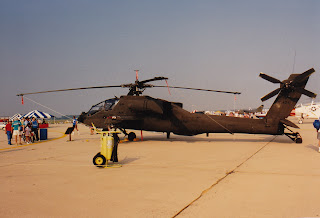The desert is dark, cold, and flat on moonless nights. There are no landmarks for navigation. The sand rises and falls and there is no real way to tell how high or low you are. You have no depth perception. Just vast amounts of nothing. On January 17th 1991 it was no different. In the western desert of Iraq there were some important targets; these targets did “light” the skies with RADAR. The Soviet designed RADARs were scanning the skies over the border with Saudi Arabia. These RADARS were constantly tested over the previous weeks. Allied forces would do what was called a “Fence Check” in the Cold War. They would streak towards the border, heading for Baghdad then, just before crossing into Iraq and would break off the attack. This happened so frequently that the Iraq RADAR operators got lulled into a sense of security. However these RADARs needed to be taken out.
Originally, the plan was to insert special operations forces to take over the RADAR sites. That was overruled by General H. Norman Schwarzkopf in November of 1990. The replacement mission became known as TASK FORCE NORMANDY. It was a joint service operation. In 1991, the AH-64As did not have the sophisticated navigation the current generation has. They could not find their targets easily in the dark nothingness of the Western Iraqi Desert. It was decided that USAF MH-53J PAVE LOW IIIs could act as navigators with their large all weather RADARs, and new-fangled Global Positioning System.
After practicing for three months, 12 aircraft, 10 United States Army and 2 United States Air Force, were prepositioned at Al Jouf Airport on January 14 from King Fahd International Airport. The MH-53s were from the 1st SOW 20th SOS; the 9 Apaches and 1 UH-60H were from the 1-101st Airborne.
The team did not wait too long. A day and a half later, they would be taking off in two groups. The AH-64s were given asymmetric load on their stub wings—with a rack of 4 AGM-114 HELLFIRE on each rack. On the left wing, a Fuel Tank; the right, a 70 mm HYDRA unguided rockets. The 30 MM chain gun was loaded with its full 1,200 rounds of ammo. One AH-64 would be a spare. The UH-60H would be set up, should there be a loss and a need to recover the crews. CH-47 Chinooks would take off and act as “Fat Cows;” they would be loaded with fuel to gas up the teams on the return, hot fueling the ships in the middle of the dark Iraqi desert.
Since there were two targets the team was divided into two flights, Red Flight and White Flight. Four AH-64s with its shepard MH-53 took off and headed northwest; 12 minutes later, the process was replicated but headed southwest.
The Flights were done with little to no communications. When there was a waypoint change, the MH-53 Crews came up with a novel way to point it out to the other Helos. They would drop out chemical lights (large light sticks) onto the desert floor.
Anyone who has ever heard a 53 will know the big Sikorsky isn’t quiet. They would not go all the way to prevent detection. So thirty nautical miles from the targets, the AH-64s surpassed the 53s and proceeded to approximately 2 miles from the RADAR sites; H HOUR was 3 AM local time. The Two flights of 64s split again into 4 flights with a mile separation, settled into a hover, and waited.
What the Army didn’t know was 37th TFW F-117s, lead by Col. Alton “Al” Whitley, had already snuck by the RADARS and were well on their way “Downtown.”
At precisely 2:38 AM Local time TASK FORCE NORMANDY released HELL FIRE on some poor unassuming Iraqi RADAR operators.
The Attacks lasted approximately 2 minutes. The Electrical generations were destroyed first. The RADARs went dark; next were the manned communications buildings and lastly were the RADARs themselves. In two minutes, 27 HELLFIRES, 100 HYDRAs and 4000 rounds of 30 Mike Mike were expended. The Iraqis had two new smoking ruins added to the landscape. The Corridor for the largest Air Armada in modern history had been opened. The Army had been the battering ram on Saddam’s Fortress Iraq. The door was down and now the troops were flooding through the door.
The Apaches headed back to friendly territory; however, even with the extra tank of gas, they were low on fuel. They needed to rendezvous with a Fat Cow; CH-47 had been prepositioned in the desert. It was loaded with precious gas. After the bloodied helos tanked up, they flew back to Al Jouf untouched.
As a side note, the Cow wasn’t so lucky. It took ground fire on its return home and lost its aft landing gear, from a shoulder launched surface-to-air missile. It did return safely and no crew was lost. A testament to the quality built in Ridley, PA!
It was only the beginning of the Apache in Iraq—a mission that still exists today.
Also check the posting time!
Works Cited
"1st Battalion, 101st Aviation Regiment." GlobalSecurity.org - Reliable Security Information. Web. 16 Jan. 2011.
.
"A Legacy of Heroes, Part 3 1975-1991 « Threedonia.com." Threedonia.com. Web. 16 Jan. 2011. .
Morse, Stan Ed. "DESERT STORM." Gulf Air War Debrief. Westport, CT: Airtime Pub., 1991. 49-52. Print.
"Task Force Normandy Fired the Opening Shots of Desert Storm." Defense Media Network. Web. 16 Jan. 2011. .
"Task Force Normandy: Iraq Veteran Recounts Desert Storm." Hurlburt Field - Home. 03 Feb. 2006. Web. 16 Jan. 2011. .

